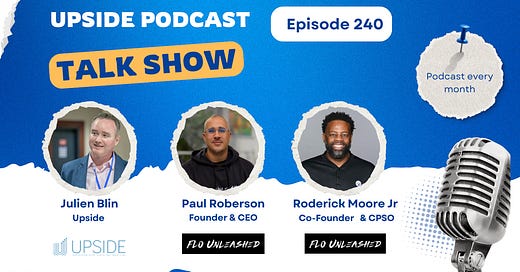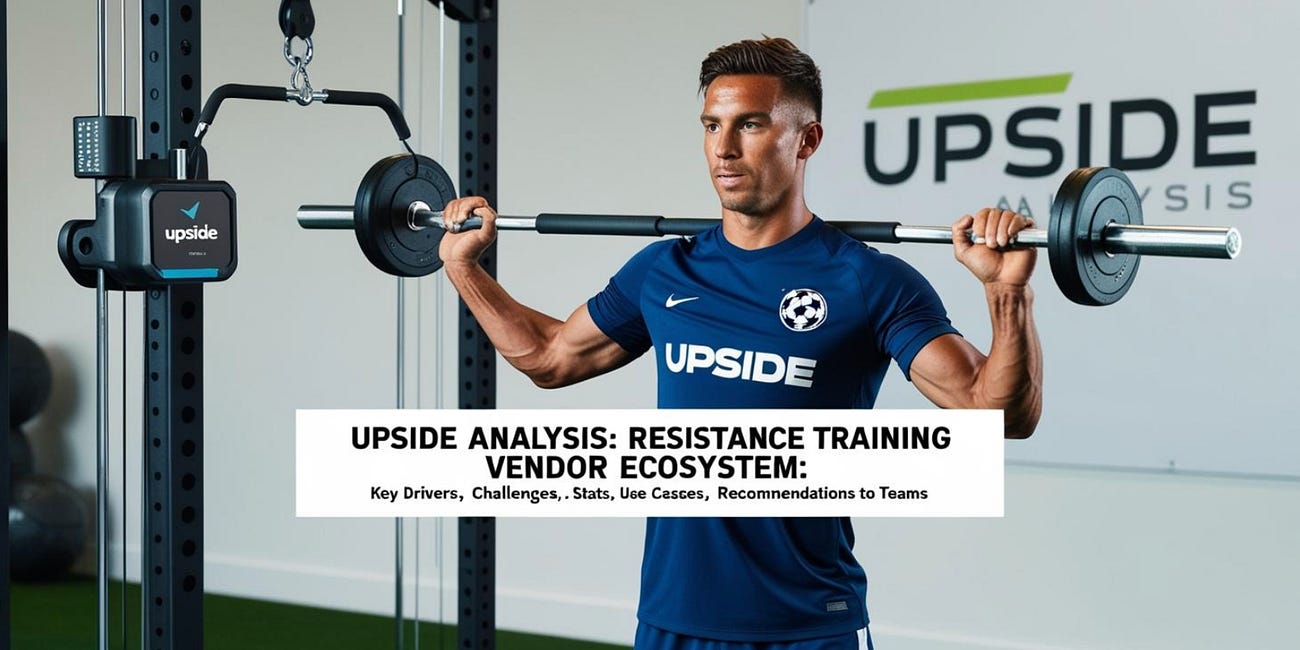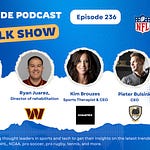Today we have the honor of interviewing Paul Roberson, founder of FLO Technology, a leading new innovative technology company focused on innovative equipment in the sports tech industry. Paul is joined on the call by Roderick Moore Jr, the co founder and Chief Performance Science Officer of the company.
FLO Technology develops a 360-degree speed and agility resistance training system. Their primary product is a system that allows athletes to train with resistance in all directions, replicating real-game movements. The system utilizes a harness and resistance bands to provide multidirectional resistance.
Key features and benefits include:
360-degree resistance training.
Enhanced muscle engagement and stability.
Injury prevention and rehabilitation applications.
Improved speed and agility.
They are also working on sensor technology to provide data insights.
Here is a video introducing their product the FLO Unleashed:
Here is a video showcasing the FLO Unleashed being used across various sports:
Customers / partners: Targets athletes of all levels, from professionals to amateurs. Aims to partner with professional and collegiate sports organizations. Also targets the direct to consumer market.
📝Show Notes: Through this interview, we touched on their respective backgrounds, their company and product, the benefits for sports organizations and teams to use their product. We also talked about their competitive advantage, business model, and their plans for the next 12 months.
You can read the full transcript of the podcast interview with Paul and Roderick located at the top of this blog post.
Here are the quotes from the interview with Paul and Roderick:
Q1. What inspired each of you to enter the performance space, and what led to the creation of FLO technology?
Paul Roberson:
“It actually started completely outside of sports. I originally wanted to bring to market the world’s first 360-degree hands-free dog leash because every time I’d go running with my dogs, it was a nightmare — constantly switching leashes between hands, ruining the rhythm of the run. I wanted something that moved with me around my hips. Fast forward a few years, and I put on a prototype of that leash and realized I’d accidentally created something athletes could use. Having played free safety and trained with a ton of performance equipment, I immediately saw that this could revolutionize the way we do resistance-based movement training. That’s how FLO Unleashed — and ultimately FLO Technology — was born.”
Roderick Moore:
“My path started in performance and education. I was at the University of Tennessee pursuing a PhD in sports psychology when I got pulled into coaching full-time. I ended up working as a strength coach, then moved into the sports tech space with companies like Catapult and Sparta Science. After years of being on both the coaching and tech side, I saw how hard it was to get the right data, the right tools, and make them practical in real settings. When I saw Paul’s prototype, it was one of those ‘aha’ moments — I immediately understood the potential and wanted to be part of building it from the ground up.”
Q2. How does FLO technology work, and what makes it unique compared to other resistance training tools?
Roderick Moore:
“The FLO Unleashed belt is a patented 360-degree harness that allows freedom of movement in all directions. Most belts are made of nylon and restrict transitions — from sprint to backpedal or shuffle to sprint — making movement clunky. With FLO, you get smooth, continuous motion and resistance across all planes. That’s a big leap forward. Athletes can sprint, cut, change direction — all with dynamic resistance that doesn’t get in the way. We like to say it bridges the gap between the weight room and the field of play.”
Paul Roberson:
“And it’s not just the hardware. What makes us different is that we’re building a full system. Soon, we’ll be layering on sensor data — measuring center of mass displacement, velocity, gait, acceleration, and deceleration. Eventually, coaches will get meaningful insights tied directly to how athletes are moving under load. We’re not just building another tool; we’re building an ecosystem.”
Q3. What kind of feedback are you getting from teams and athletes? Any standout success stories?
Roderick Moore:
“We’ve used it with defensive backs in both Atlanta and Pittsburgh. One example that sticks out — before games, players would warm up with traditional bungees and complain about how awkward it felt when transitioning between movements. When we introduced FLO, one of our guys said, ‘This is the smoothest warm-up I’ve ever had — I can actually feel my body syncing with the movement.’ That’s the kind of feedback we’re getting: better movement quality, smoother transitions, and more natural resistance. It’s intuitive, and athletes feel it right away.”
Paul Roberson:
“Teams like BYU (NCAA) and the Cardinals (NFL) have reached out to us — we didn’t chase them. That tells you something. We’re seeing adoption in football, but also basketball, tennis, rehab, even recreational use. Because it’s so adaptable, it’s being pulled into use cases we didn’t initially expect — like return to play protocols and rehab centers where the smooth resistance and mobility of the belt makes it ideal.”
Q4. From a scientific standpoint, what’s happening in the body when using FLO? What measurable impacts are you seeing?
Roderick Moore:
“FLO allows athletes to train with load in dynamic, multi-directional environments. That means you're activating stabilizing muscles and fast-twitch fibers without joint impact. In the future, once we integrate sensors, we’ll measure things like force output, stride variability, and power application in real-time. But even now, the athletes feel the difference. They’re engaging their core and stabilizers in a way that mirrors real game movement.”
Paul Roberson:
“You’re training for functional explosiveness in every plane of motion. Traditional resistance training is great for strength, but it doesn’t always translate directly to game-speed or cutting angles. FLO creates resistance while you move the way you play. That’s a huge physiological shift — and it shows in things like faster transitions, cleaner footwork, and better deceleration control.”
Q5. What is your business model, and how are you positioning FLO in the sports performance ecosystem?
Paul Roberson:
“We’ve got a dual business model. First, it’s hardware — we sell the belts, and that gets us into the market. But the long-term value is in the software. Once the sensors are fully embedded, teams can opt into a subscription model — getting real-time analytics, performance trends, and benchmarks. It’ll be $35,000 to $50,000 annually for access to the full data platform. Compared to legacy systems like Catapult that cost $100,000 and provide only data without the training tool — we offer a lot more value.”
Roderick Moore:
“We’re not trying to disrupt everything teams already have. We’re building a complementary system that enhances what’s already in place. Whether it’s resistance training, sprint profiling, or return-to-play — FLO can slide right into existing workflows.”
Q6. What differentiates FLO from competitors in design, outcomes, and integration?
Roderick Moore:
“It’s not just another device — it’s a hybrid. You can use FLO standalone or as a complement to platforms like 1080 Motion, OHM, or Vald. With FLO, you’re not stuck with fixed equipment in one place. You can train indoors, outdoors, during practice, or in rehab. It’s flexible, portable, and data-enabled.”
Paul Roberson:
“We designed this for athletes, by athletes. I didn’t come at this like an engineer — I came at it like a guy who’d worn every belt on the market and thought, ‘Why does this suck?’ We’re solving real problems — not building tech for the sake of tech. That’s why when I demo it, I don’t even pitch. I just say, ‘Put this on.’ They feel it. That’s the sell.”
Q7. What’s coming in the next 12 months for FLO Technology?
Paul Roberson:
“Right now, we’re manufacturing in Northern Nevada and scaling distribution to early adopters — the Steelers, Falcons, University of Tennessee, UFC teams, and others. We're also actively fundraising and expect to close a $3 million pre-seed round within the next 60 days. That will allow us to accelerate development of the tech-enabled carriage and activate our full subscription model.”
Roderick Moore:
“The roadmap is ambitious — but achievable. We want to hit 50,000 units in the next year, deploy the sensor-enabled version of the belt, and expand into verticals like rehab and youth sports. Partnerships, software updates, and data validation with research teams are all on deck. We’re building a foundation that’s scalable — from elite performance to everyday fitness.”
You may also like:
🏋️ Upside Analysis: Resistance Training Vendor Ecosystem: Key Drivers, Challenges, Stats, Use Cases, Vendors, Recommendations to Teams
In high-performance sports, resistance training has historically been the foundation of strength and conditioning. However, over the past decade, there has been a seismic shift from traditional, manually controlled equipment to smart, programmable, and data-driven resistance systems. These systems allow for highly controlled, measurable, and adaptable t…














Share this post